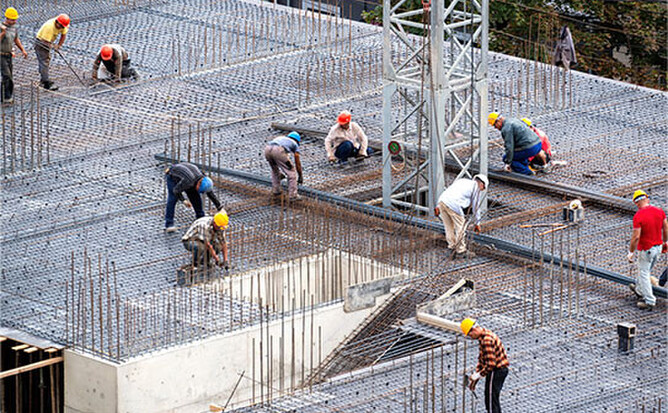Construction projects differ significantly based on their intended use, design requirements, and compliance regulations. Industrial vs commercial construction projects require specialized planning to ensure buildings meet structural, functional, and safety demands. Industrial facilities, such as manufacturing plants and warehouses, must withstand heavy machinery, high-load capacities, and complex mechanical systems. Commercial buildings, including offices, retail stores, and hospitality establishments, prioritize accessibility, aesthetics, and customer experience. The materials, building codes, and structural reinforcements vary, affecting overall durability and functionality.
Making informed decisions about industrial vs commercial construction ensures that projects align with operational needs, safety standards, and long-term sustainability. Understanding the core differences between these two construction types helps stakeholders choose the right approach for their specific requirements. Learn how materials, structural loads, design standards, and regulatory requirements shape industrial and commercial building projects.
Building Materials and Structural Load Requirements
Industrial construction demands materials that withstand high-impact operations, heavy equipment, and frequent mechanical stress. Steel-reinforced concrete, structural steel, and precast panels ensure stability under extreme conditions. These buildings require reinforced foundations, high-load-bearing floors, and fire-resistant components. Warehouses, manufacturing plants, and processing facilities incorporate durable roofing systems that support ventilation, piping, and safety mechanisms. Commercial construction prioritizes aesthetic appeal, energy efficiency, and occupant comfort. Glass facades, lightweight steel framing, and sustainable materials help achieve modern, visually appealing designs. Retail centers, office buildings, and hospitality spaces require materials that balance durability with design flexibility.
Load requirements in industrial construction differ significantly due to machinery weight, mezzanine structures, and production lines. Engineers design flooring systems with higher compressive strength, vibration resistance, and impact absorption. Commercial structures, on the other hand, accommodate occupant loads, storage spaces, and utilities without the need for extensive reinforcement. Structural calculations focus on maximizing open layouts, ensuring accessibility, and incorporating energy-efficient materials.
Design Standards for Functionality and Durability
Industrial buildings require layouts that optimize workflow, safety, and efficiency. High ceilings, wide-span structures, and specialized zones accommodate conveyor systems, assembly lines, and robotic automation. Ventilation, dust control, and soundproofing features enhance productivity while maintaining compliance with environmental standards. Large docking areas, reinforced loading bays, and overhead crane support are common features in industrial spaces. Commercial spaces prioritize customer engagement, employee comfort, and branding consistency. Open floor plans, natural lighting, and ergonomic designs create inviting environments for offices, retail stores, and entertainment venues.
Functionality and durability remain key considerations in both industrial and commercial designs. Industrial projects integrate corrosion-resistant materials, impact-resistant flooring, and heavy-duty insulation for long-term resilience. Commercial projects incorporate energy-efficient lighting, smart climate control, and high-traffic flooring to withstand daily operations. Architects and engineers tailor designs to align with business objectives while adhering to safety and building regulations.
Electrical and Mechanical System Installations Differ
Industrial facilities require specialized electrical systems that support heavy machinery, automated processes, and high-voltage equipment. Power distribution panels, industrial-grade transformers, and dedicated circuits ensure continuous operation without interruptions. Backup power systems, redundant safety mechanisms, and surge protection features prevent equipment failure and operational downtime. Mechanical installations include advanced HVAC systems, industrial ventilation, and process-specific piping for manufacturing and warehousing applications. Fire suppression systems, dust collection units, and temperature-controlled storage facilities enhance operational safety.
Commercial buildings prioritize energy efficiency, occupant comfort, and regulatory compliance in electrical and mechanical installations. Standard voltage systems, smart lighting controls, and modular HVAC units reduce operational costs while maintaining indoor air quality. Retail establishments, office buildings, and mixed-use developments integrate climate zoning, automated temperature controls, and LED lighting for sustainability. Electrical and mechanical components support customer experience, employee productivity, and overall building performance.
Zoning Laws and Compliance Regulations Vary
Industrial construction projects must comply with stringent zoning laws, environmental regulations, and industry-specific codes. Manufacturing plants, distribution centers, and chemical processing facilities follow hazardous material handling guidelines, emissions standards, and occupational safety regulations. Land use restrictions, waste disposal policies, and transportation access requirements impact site selection and project planning. Permit approvals often involve inspections for fire safety, industrial emissions, and structural integrity before operational clearance.
Commercial construction follows building codes focused on accessibility, public safety, and business operations. Fire exits, ADA-compliant access points, and energy efficiency requirements shape commercial building designs. Zoning regulations determine permissible building heights, parking space allocations, and signage placements for commercial properties. Permitting processes involve inspections for fire alarms, elevators, and emergency response systems before project completion. Compliance with municipal, state, and federal guidelines ensures businesses operate within legal frameworks.
Construction Timelines and Project Costs Comparison
Industrial projects typically involve extended construction timelines due to specialized requirements, complex mechanical installations, and compliance approvals. Site preparation, foundation work, and structural reinforcements require precise engineering to support manufacturing equipment, storage facilities, and production workflows. The use of high-strength materials, industrial-grade installations, and automation integration affects overall costs. Industrial construction often requires customized solutions, increasing project budgets and lead times.
Commercial projects adhere to structured timelines, focusing on efficiency, aesthetics, and tenant occupancy readiness. Prefabrication, modular construction, and standardized materials streamline project execution. Budget considerations involve interior finishes, branding elements, and operational infrastructure. Office buildings, shopping centers, and hospitality venues require flexible construction approaches to meet investor expectations and customer experience goals. The cost of commercial construction depends on location, material selection, and design complexity.
Bring Your Plans to Life with Industrial Construction Contractors New York
Precision and durability shape successful industrial and commercial projects. Our expertise in industrial construction contractors in New York ensures that manufacturing plants, warehouses, and distribution centers meet high-performance standards. We design and build facilities that support heavy-duty operations, advanced mechanical systems, and long-term reliability. As trusted commercial building contractors in NYC, we create modern office spaces, retail centers, and hospitality venues that enhance functionality, aesthetics, and business growth. Every project receives careful planning, quality craftsmanship, and efficient execution for lasting value.

